Have ever wanted to emulate an artist’s style?
Of course, we all know that you can easily reference an artist’s name in Midjourney in order to apply their style to the image.
But what if you wanted to do something similar without referencing the artist’s name at all?
In this guide, I’ll show you how Midjourney artist style emulation works and how surprisingly good it is.
Let’s dive right in.
Table of Contents Show

Like this content? Then share it!
Midjourney Artist Style Emulation
www.tokenizedhq.com
Here’s the answer. Great article by @ChrisHeidorn right here: https://tokenizedhq.com/midjourney-artist-style-emulation/
The Reference
Before we get started, let me quickly introduce you to the artist that I’ll be using for this demonstration: Arthur Adams
If you’re not familiar with Arthur Adams, he is an American comic book artist who is best known for his intricate and detailed artwork.
He has worked for Marvel Comics, DC Comics, and various independent publishers.
Adams is particularly known for his work on X-Men, Godzilla, and various superhero titles.
Needless to say, his art style is popular and well-known across the board, even if you’ve never actually heard of him.
His art style is also known to Midjourney.
So if you enter things like “in the style of” or “by Arthur Adams”, you will most likely get an art style that resembles the way he draws.
Let me show you some examples straight from within Midjourney.
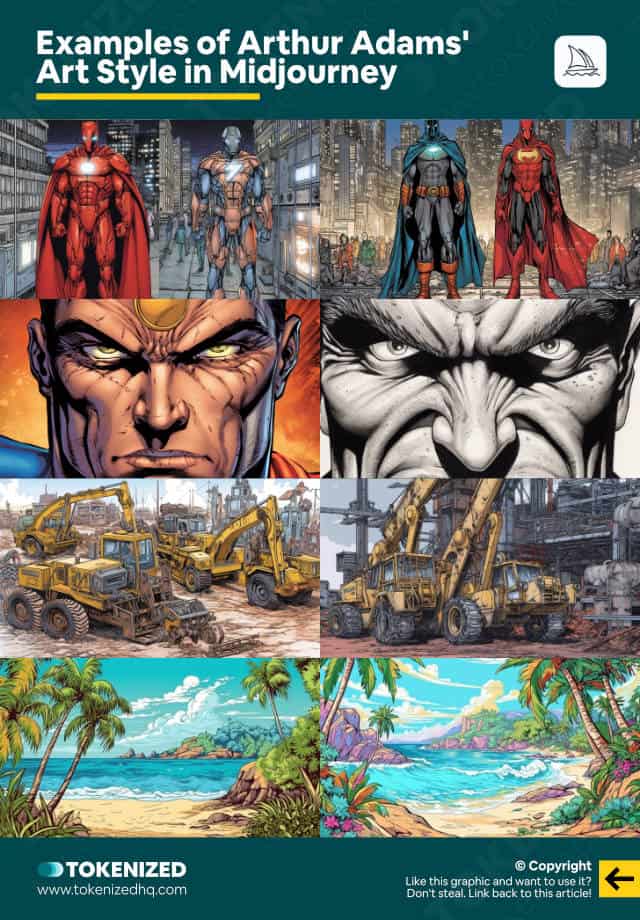
And even though some subjects are uncommon for this artist, Midjourney is still pretty good at getting the style right.
So if it’s that easy to replicate an artist’s style in Midjourney, why would we want to do it without referencing the name?
Well, there are a number of possible reasons but they’re obviously hotly debated.
I personally never reference any artists explicitly, unless it’s for educational purposes.
And I generally prefer to use text-based style prompts that allow me to fine-tune a style to my liking.
Especially because not all artist styles work equally well for every type of scene.
Plus, I love being surprised by the randomness that Midjourney has to offer.
Alright, so enough about Arthur Adams, let me show you how this works.
If you like, you can also consume this content in form of a YouTube video.
Key Points (tl;dr)
- Almost everyone knows how to apply the style of a well-known artist to a prompt in Midjourney.
- But very few people know how to emulate an artist’s unique style without referencing their name directly in the prompt.
- Midjourney artist style emulation is a novel approach to creating custom styles that are free from any particular link to an artist but still produce a very similar style.
A Message to Content Thieves
Unfortunately, my articles are often subject to content thieves, who either copy my articles entirely or put little effort into coming up with original insights. The structure of their content makes it obvious that it was lifted from here. And in all cases, they do not give credit or link back. They are reading this and they know who they are.
I have created a Wall of Shame, dedicated to them.
Extracting a Style’s Essence
I start off by opening up ChatGPT because we’re going to use its vast knowledge to figure out the essence of Arthur Adams’ unique style.
I’m going to demonstrate this with GPT 3.5, simply because everyone has access to it.
You could probably get better results by using GPT4 but for most cases, 3.5 will do.
So I started off by asking ChatGPT whether it knew who Arthur Adams is.
Do you know the art of Arthur Adams? Don't lie.It confirmed that it was aware of who he is and what he does.
This is obviously crucial for this method to actually work.
I then asked it to describe his art style in 4-5 keywords.
If you had to describe his art style in 4-5 keywords, what words would you choose?Its response was great but not really in the format that I needed.
This is an excellent example of why it’s so crucial that you formulate your prompt correctly.
I'm not asking you to share an opinion. Imagine you had to provide a very descriptive prompt for an AI art generator. Give me 4-5 keywords or partial phrases that would help the AI art generator understand how to style an image according to Arthur Adam's unique art styleSo I clarified what I really wanted it to do.
I needed descriptive words that I could use to craft a prompt for Midjourney.
Sure, here are 4-5 keywords or partial phrases that could help an AI art generator understand how to style an image according to Arthur Adam's unique art style:
- Fine details and intricate linework
- Dynamic and action-packed scenes
- Characters with a sense of weight and physicality
- Playful character designs and expressions
- Emphasis on realistic anatomy and proportionsIts next response was excellent because really broke things down into concepts.
You could easily just convert all of these into a long string of text and add them to a prompt.
But since I’m a lazy man, I asked it to put it into the correct format for easy copy and pasting.
And sure enough, it did just that.
But I wasn’t done yet, so I asked ChatGPT whether Adams used a typical color scheme in his art.
It then explained that Arthur Adams is mostly known as a penciler.
This also explains why Midjourney will frequently generate images in black and white.
The very same thing happens whenever you use the term “lineart” for obvious reasons.
However, ChatGPT also added that the colorists will usually choose a palette that helps add depth to the linework.
And it also said that the colors tend to be bold and saturated.
This is really useful stuff.
So now that I had a good description of the key aspects of his art style as well as some detail on the color scheme, I tried to figure out whether there was a term that summarized his style in a single term.
If you had to summarize his art style in a a single term that is widely known and documented, what would that be.ChatGPT gave me a bit of a “duh!” answer.
It mentioned “highly detailed”, but I didn’t find that very useful for what I was trying to achieve.
I asked ChatGPT whether this term was considered a recognized art style.
The reason I did this is that I was looking for a word that I could reasonably assume Midjourney may have been trained on.
And ChatGPT confirmed my concerns by explaining that it’s a common type of art style but is also used in many different fields of art.
This obviously makes it difficult to distill it down to the unique case of Arthur Adams’ style.
So I decided to ask ChatGPT to name a formal art movement or style that best fits Arthur Adams’ style.
Name a formal art movement or style that best fits Arthur Adam's style.And this time it gave me something useful to work with, citing the term “image comics”.
You could argue that “image comics” is a bit generic, but it’s actually not.
To be fair, there’s even a publisher that is called “Image Comics”, so it’s quite likely that there is more than enough visual material on the internet.
Next, I asked ChatGPT whether it could attribute a typical mood to Adams’ art style.
On the hand, it said it was difficult to reduce it to a single typical mood.
Then it presented me with some concrete examples of different moods.
But ironically, it ended up offering me a generalized theme of “fun and adventure”.
Since most of its responses are just way too long for my taste, I asked it to reduce it to 2-3 keywords.
Just give me 2-3 keywords or partial phrases for the mood.Its response was perfect, with 3 very useful phrases.
Sure, here are 2-3 keywords or partial phrases that could describe the mood of Arthur Adams' art style:
- Exciting and dynamic
- Playful and whimsical
- Fun and adventurousOnce again, being the lazy man that I am, I asked for proper formatting.
ChatGPT is always so polite.
It apologized for its oversight and served it up on a silver platter for me.
Since this seemed to work quite well, I asked it to do the very same thing with Adam’s typical genre and theme.
And sure enough, it gave me 2-3 useful phrases that I could use in my prompt.
Sure, here are 2-3 keywords or partial phrases that could describe the typical genre and theme of Arthur Adams' art style:
- Superhero and action-adventure
- Fantasy and science fiction
- Pop culture and nostalgiaSo now that we’ve gathered all this information, how do I turn this into an art style that can be prompted in Midjourney?
Let’s start off with descriptive keywords. Do you remember these?
- Fine details and intricate linework
- Dynamic and action-packed scenes
- Characters with a sense of weight and physicality
- Playful character designs and expressions
- Emphasis on realistic anatomy and proportionsWe decided that we didn’t want any references to characters, so we were left with the first two and the last two.
These form the core of our style prompt.
fine details, intricate linework, dynamic composition, emphasis on realistic proportionsThen we add the overarching art movement or style at the beginning of the prompt.
image comics style, fine details, intricate linework, dynamic composition, emphasis on realistic proportionsFrom our list of moods, we’ll keep the second and the third one and add them at the end of the prompt.
So the new prompt looks like this.
image comics style, fine details, intricate linework, dynamic composition, emphasis on realistic proportions, playful and whimsical, fun and adventurousAnd finally, from our list of genres and themes, we’ll go with the 2nd and 3rd options as well.
We add them to the end of our prompt, completing our full style prompt that is meant to replicate Arthur Adams’ style.
image comics style, fine details, intricate linework, dynamic composition, emphasis on realistic proportions, playful and whimsical, fun and adventurous, fantasy and science fiction, pop culture and nostalgiaApplying the Style
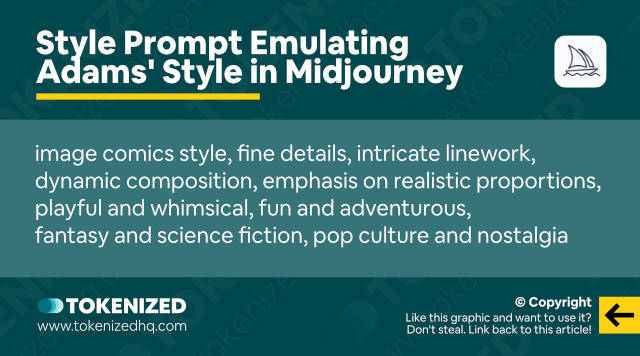
Using this style prompt, you can now create more or less any type of image you like and maintain a style that looks strikingly similar to Arthur Adams.
And this text prompt doesn’t require you to reference him in any way.
In fact, the words you’ve used do not have any direct link to him.
For all intents and purposes, this could be anyone’s style.
But you’re probably wondering how close it is to the original?
Well, let’s find out.
Here’s a prompt for the inside of an alien spaceship.
/imagine
inside of an alien space ship, image comics style, fine details, intricate linework, dynamic composition, emphasis on realistic proportions, playful and whimsical, fun and adventurous, fantasy and science fiction, pop culture and nostalgia --v 5 --ar 4:5As you can see, I start off with the subject of the image.
I then add the entirety of our newly-crafted style prompt and simply add some parameters.
What you’ll immediately notice is that most of these images are black and white.
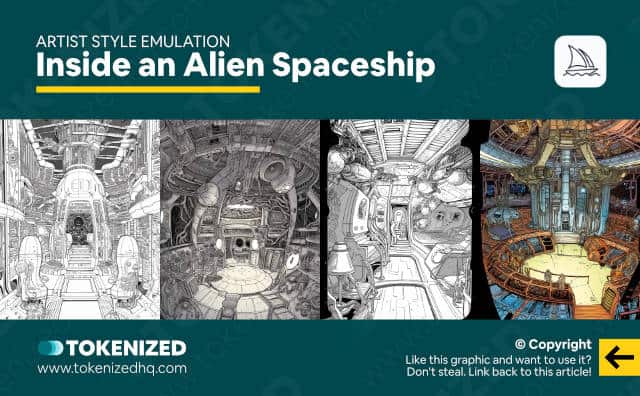
This is totally in line with what we would expect.
Remember, Arthur Adams is a penciler and intricate linework is essentially the phrase that triggers this.
Luckily, consistently adding color to this is much easier than you might think.
All I need to do is add a small detail.
/imagine
inside of an alien space ship, image comics style, full color, fine details, intricate linework, dynamic composition, emphasis on realistic proportions, playful and whimsical, fun and adventurous, fantasy and science fiction, pop culture and nostalgia --v 5 --ar 4:5Notice the “full color” phrase that I’ve added after the over-arching art movement?
That’s it. Problem solved.
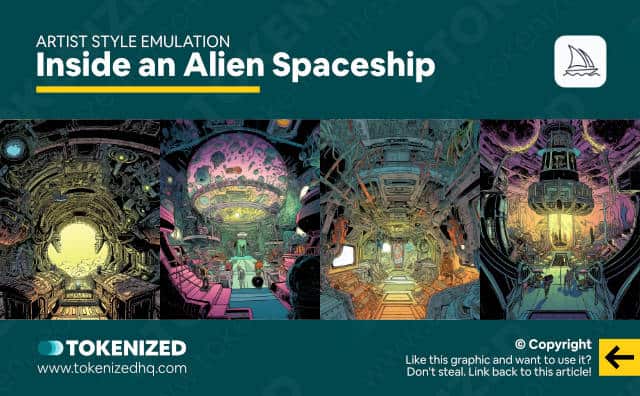
As you can see in these images, they’re now in full color and still use the same style.
So how does this style compare to the original Arthur Adams?
Well, let’s find out.
Here’s what the prompt would look like if you wanted to reference the artist (also check out our article on the Midjourney styles reference).
/imagine
inside of an alien spaceship
by Arthur Adams, full color --ar 4:5 --v 5It’s just the subject, followed by the artist and also the “full color”.
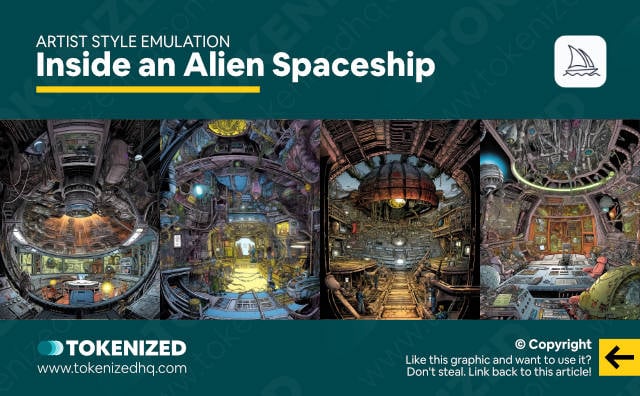
Even though I’m sure you’ll find good reasons why you believe this is much better, more detailed, or not at all the same.
Let’s face it, the style is strikingly similar.
And also similar enough that you’d probably have a hard time telling the difference.
Unfortunately, the examples I’ve shown you so far aren’t ideal for that sort of comparison.
If we really want to compare these 2 prompts, then we’ll have to use the same seed.
The Showdown
So let’s whip up our original prompt one more time.
/imagine
inside of an alien space ship, image comics style, full color, Fine details, intricate linework, dynamic composition, emphasis on realistic proportions, playful and whimsical, fun and adventurous, fantasy and science fiction, pop culture and nostalgia --v 5 --ar 4:5 --seed 732446427The only difference is that I’ve set a seed.
Everything else about this prompt is exactly the same.
We’ll have a look at the inside of our spaceship with our style prompt in a minute.
We still need to do the very same thing with Arthur Adams, using the exact same seed.
/imagine
inside of an alien spaceship
by Arthur Adams, full color
--ar 4:5 --v 5 --seed 732446427I know it might be a bit difficult to compare them separately.
So let’s check out each quadrant side-by-side.
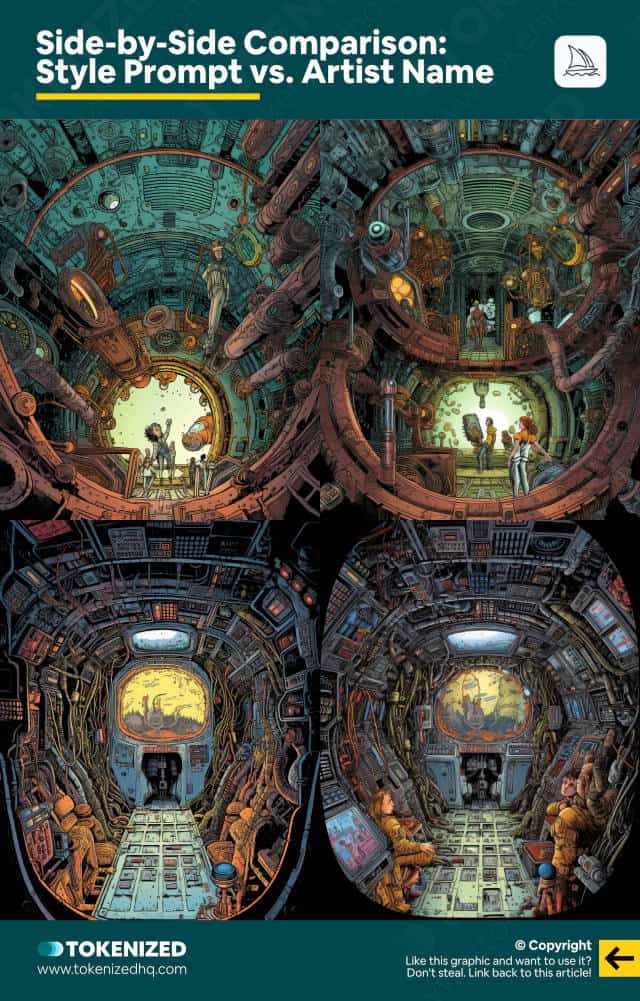
And of course, these images are still different.
However, if you pay close attention, you’ll notice that they aren’t as far apart as you might that thought they would be.
So the much bigger question is:
What does this tell us about how Midjourney replicates artists’ styles?
Are the names of certain artists just keywords that trigger a collection of descriptors?
Unfortunately, I don’t know enough about how large language models, diffusion models, and embeddings really work under the hood.
But this obviously raises some interesting questions.
More Examples
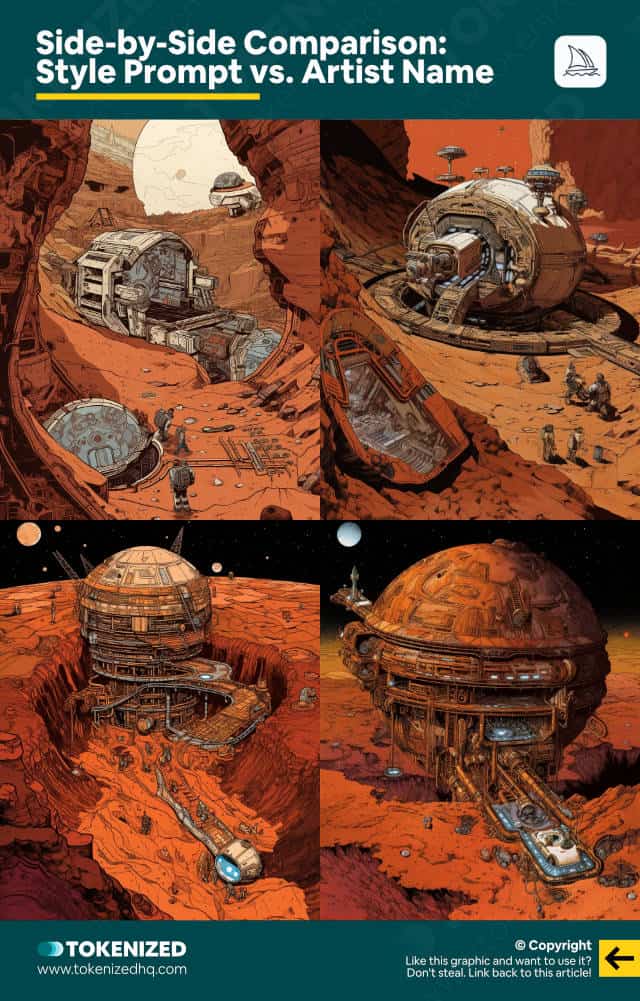
Before we finish, I’d like to share a few more examples.
I shared some of these images on social media a few weeks ago.
While I do think that there is a superior level of detail in the images that directly reference Arthur Adams, the replicated style comes very close.
And it’s also interesting to see how the seed maintains certain similarities.
You can’t really see it well, even when shown side-by-side.
The best way to check is to flip back and forth between both images.
That’s when you really start to notice the similarities.
Here are the prompts.
/imagine
space station on the surface of mars, image comics style, full color, Fine details, intricate linework, dynamic composition, emphasis on realistic proportions, playful and whimsical, fun and adventurous, fantasy and science fiction, pop culture and nostalgia --v 5 --ar 4:5 --seed 2023/imagine
space station on the surface of mars by Arthur Adams, full color --ar 4:5 --v 5 --seed 2023I’m using a seed of 2023 on both of them.
Above you can see a side-by-side comparison.
Pretty neat, isn’t it?
Just imagine what this means for your very own work.
You no longer necessarily have to rely on referencing specific artists if you don’t want to.
And who knows, you just might discover completely new variations of a style, that you prefer.
Either way, I think these are some incredibly interesting insights into how styles work in Midjourney.
Frequently Asked Questions (FAQ)
Before we close off this guide, let’s quickly address some of the most common questions related to Midjourney artist style emulation.
-
How can I use an artist’s style in Midjourney?
The easiest way to do this is to simply mention the artist’s name in your prompt. This is usually done in combination with “by [ARTIS NAME]” or “in the style of [ARTIST NAME]”.
-
Is it possible to copy an artist’s style without using their name in Midjourney?
Yes, it is possible to replicate the unique style of an artist without referencing their name in the prompt. However, Midjourney artist style emulation is a process of trial and error and will most likely require the assistance of someone who is familiar with the art style and movement. Alternatively, you can also get some help from ChatGPT.
Conclusion
Applying the style of real-life artists to AI-generated images is one of the earliest tricks that Midjourney had up its sleeve.
But some people do not feel comfortable referencing artists directly because they believe it is just a step too far.
With the approach I shared above, you no longer need to do that and simply emulate any given style you want.
Here at Tokenized, we want to help you learn as much as possible about the AI software industry. We help you navigate the world of tech and the digitalization of our society at large, including the tokenization of assets and services.



